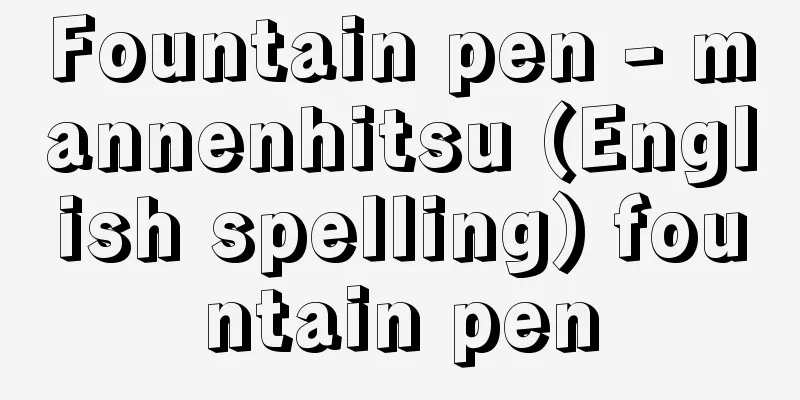Fountain pen - mannenhitsu (English spelling) fountain pen

|
A type of writing instrument that uses capillary action to draw ink from inside the barrel and pass it through the nib to write. [Matsuo Nozawa] historyStructurally, the first pen was invented in 1809 by British sculptor Frederick B. Forsch, who invented a valve-type pen in which ink stored in the barrel was sent to the pen by opening a valve at the rear of the barrel. In the same year, fellow British sculptor Joseph Bramah invented a pen in which ink was dispensed by pressing the barrel with a finger, which he named the fountain pen. The current principle of using capillary action to dispense ink was invented by American insurance salesman L. E. Waterman in 1884, and this principle has been used ever since. In Japan, Maruzen Co., Ltd. in Tokyo first sold Waterman pens in small quantities in its stores in 1895 (Meiji 28), and full-scale imports began after 1902 (Meiji 35). Eventually, Fukui Shoten in Osaka and other stores began to carry brands such as Waterman, Pelikan, and Dragon, and imported fountain pens were at their peak from the end of the Meiji period to the Taisho period. Around that time, several companies began to make domestic fountain pens, and while at first fountain pens were imported from overseas and assembled domestically for sale, by the Taisho period they were able to produce 100% domestically produced pens. There are various theories about the origin of the name "fountain pen," but one theory is that a writing instrument with a gold-plated nib attached to the barrel that Fukui Shoten imported at the end of the Meiji period was called the "NY fountain pen," and so this name was given to this type of writing instrument. Another theory is that Mankichi brushes were named after the importer at Maruzen at the time, and later became fountain pens. However, it is now generally believed that the name was given by Uchida Roan to mean a brush that could be used for a long time. [Matsuo Nozawa] kindsThere are many different types, but they can be categorized into the following three types based on their shape. [1] Standard type: A basic type with a long shaft and a short sheath. [2] Short type: Also called the mini type, this type has a short shaft and a long sheath. It is convenient because it is short when carrying and long when writing. [3] Capless: A pen without a cap, with the pen tip retracted by knocking or rotating. Other types (methods of ink refilling) include the following: [1] Cartridge type: Also called the spare type, this type allows ink to be refilled simply by replacing the ink already in the cartridge. [2] Center push type: A suction type with a composite metal cover attached to the outside of the ink tube, and ink is refilled by manipulating the center or tail. [3] Other: Currently there are few varieties, but there are pump type, lever type, center core type, and retractable type. [Matsuo Nozawa] Pen tip14-karat gold pens are common because they are not affected by the acid in the ink, but recently, excellent acid-resistant alloys have appeared, and stainless steel and gold-plated stainless steel pens are also widely available. The tip of the nib is made of iridium, a wear-resistant alloy. A good pen has smooth ink flow, is elastic, and writes smoothly. [Matsuo Nozawa] "Fountain Pen" by Haruo Umeda (1979, Seidosha)" ▽ "Fountain Pen" by Haruo Umeda, photographed by Tadashi Omori (Heibonsha Color Shinsho)" ©Shogakukan "> The structure of a fountain pen and the names of each part of the nib Source: Shogakukan Encyclopedia Nipponica About Encyclopedia Nipponica Information | Legend |
|
筆記具の一種。軸内に蓄えたインキを毛細管現象によって引き出し、ペン先を通して書写する仕組みになっている。 [野沢松男] 歴史構造的には、1809年イギリスのフレデリック・B・フォルシュが、軸後部のバルブを開いて軸内に貯蔵したインキをペン部に送るバルブ式のものを発明したのが最初である。同年、同じイギリスのジョセフ・ブラマーが、軸を指で押してインキを出すものを考案し、これをファウンテンペンfountain penと名づけた。現在のような毛細管作用を用いてインキを導き出す原理は、1884年アメリカの保険外交員L・E・ウォーターマンの考案によるもので、この原理がその後も受け継がれている。 日本では1895年(明治28)に東京の丸善(株)が、少量だがウォーターマンのものを店頭で発売したのが最初で、本格的な輸入は1902年(明治35)以降のことである。やがて大阪の福井商店なども、ウォーターマンをはじめペリカン、ドラゴンなどの銘柄を扱うようになり、明治末期から大正時代にかけては舶来万年筆の全盛時代となった。またそのころから国産万年筆が数社でつくられるようになり、最初は外国から輸入したペン先を国内で組み立てて販売していたのが、大正時代になって純国産のものができるようになった。「万年筆」という名のおこりには諸説があってさだかではないが、明治末期に福井商店で輸入していた、軸に金めっきのペン先を取り付けた筆記具を「NY万年ペン」とよんでいたことから、同種の筆記具にこの名がつけられたとする説や、当時の丸善の輸入担当者の名前をとって、万吉筆がのちに万年筆となったとする説などがある。しかし現在では、末長く使える筆という意味で内田魯庵(ろあん)がつけたというのが通説となっている。 [野沢松男] 種類種類は多種多様であるが、形態別に分けると次の三つになる。〔1〕スタンダードタイプ 軸部が長く、鞘(さや)部の短い基本的なタイプ。〔2〕ショートタイプ ミニタイプともいい、軸部が短くて鞘部が長い。携帯時には短寸で、筆記時には長寸になるという便利性がある。〔3〕キャップレス キャップがなく、ノックや回転によってペン先を出没させるシステムのもの。このほか機構(インキ補給方法)では次のようなものがある。〔1〕カートリッジ式 スペア式ともいい、あらかじめカートリッジ内に入れておいたインキを交換するだけでインキ補給のできるもの。〔2〕中押し式 吸入式で、インキチューブの外側に合金属のカバーをつけ、その中央部や尾部を操作することによりインキ補給をするタイプ。〔3〕その他 現在は品種が少ないが、ポンプ式、てこ式、中芯(しん)式、繰り出し式など。 [野沢松男] ペン先インキ中の酸に侵されないため14金ペンが一般的だが、最近では優れた耐酸合金も現れ、ステンレス材のものや、それに金めっきしたものも多く出回っている。なおペン先の先端には耐摩耗合金のイリジウムが装着されている。インキの流出がスムーズで弾力性があり、書き味の滑らかなものが良品である。 [野沢松男] 『梅田晴夫著『万年筆』(1979・青土社)』▽『梅田晴夫著、大森忠写真『万年筆』(平凡社カラー新書)』 ©Shogakukan"> 万年筆の構造とペン先の各部名称 出典 小学館 日本大百科全書(ニッポニカ)日本大百科全書(ニッポニカ)について 情報 | 凡例 |
<<: Perpetual snow (English spelling) firn; névé
>>: Ganoderma lucidum (mannentake) - Ganoderma lucidum (mannentake)
Recommend
Election - Election
〘 noun 〙 A system in which the emperor himself set...
Alcyoniidae
...A general term for coelenterates (Cnidarians) ...
Reason - Dori
〘 noun 〙① The way things should be. The natural co...
Bourbon, Duc de (English spelling) BourbonDucde
…[Hiroyuki Ninomiya]. … *Some of the terminology ...
The Republic of the Five Races (English: Wu-zu gong-he)
A slogan advocated during the Xinhai Revolution in...
Overheated Locomotive - Kanetsuki Kansha
...In 1887, the first American locomotive was imp...
geōmetria (English spelling) geometria
…However, in mathematics that bears the name of g...
Ugarit (English spelling)
A Neolithic to Bronze Age ruins in Ras Shamra, abo...
makutam
...The rhythm is highly developed, and improvisat...
Amphitheater - Enkeigekijo
A theater with spectator seats arranged in a circ...
Volcanic ash soil
Soil whose parent material is volcanic ash. When ...
Amorphophallus titanum (English name) Amorphophallustitanum
…[Yoshiharu Iijima]. … *Some of the terminology t...
Perihelion rotation
If a planet moves due to the gravitational force f...
Ukiyoburo - Ukiyoburo
This is a humorous book written by Shikitei Sanba...
Brazil nuts
A tall tree of the family Barringtaceae (APG clas...









